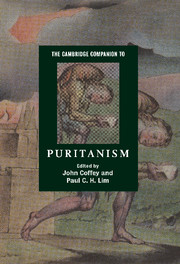3 - Early Stuart Puritanism
from Part I: - English Puritanism
Published online by Cambridge University Press: 28 November 2008
Summary
To provide an account of early Stuart Puritanism is, in a sense, to attempt an objective description of a chimera. To look for a creature with a consistent essence, a teleology and an ever-present set of characteristics is counterproductive in that it takes as given exactly that which must be addressed, it assumes what should be at the heart of the question, namely whether, between 1603 and 1640, there was something with sufficiently constant attributes to deserve the unifying term of 'early Stuart Puritanism'. Something like a teleology, or at least a narrative, will be set out, but in order for its status as a meta-narrative to be engaged with as a way of making explicit the issues of contingency and the contextually dependent nature of the identity of the beast. / The changing context of the new reign / The start of the new regime found Puritanism as ambivalent. On the one hand, one result of the Marprelate controversy, the furore over sensationalists like Francis Hacket, the relations with separatists, the legal and literary exchange over the efforts of John Darrell et al. to heal the possessed and the Whitgiftian drive for conformity, was to create multiple responses from Puritans, some seeking distance from disreputable means, others willing to defend their causes. On the other hand, the arrival of a monarch seen as sympathetic to 'reformed' Protestantism encouraged many to bide their time in the hope of a supreme governor closer to their mindset. This tension can be seen to run through individuals as the parodic epitaph attached to Archbishop Whitgift's hearse shows: the investigation revealed connections from more peripheral opponents to ministers fostering reform from within the royal court. This tension between appropriation and subversion will be a recurring theme.
- Type
- Chapter
- Information
- The Cambridge Companion to Puritanism , pp. 48 - 66Publisher: Cambridge University PressPrint publication year: 2008
- 6
- Cited by

